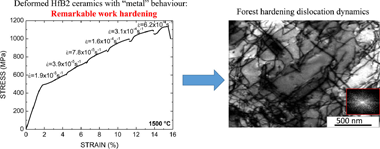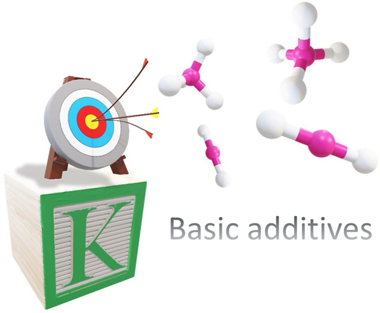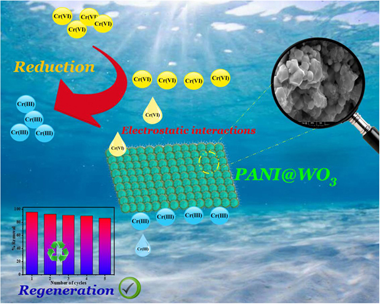Artículos SCI
2021
2021
Propiedades mecánicas, modelización y caracterización de cerámicos avanzados
HfB2 ceramic polycrystals: A low-temperature metal-like ceramic at high temperatures?
Zapata-Solvas, E; Moshtaghioun, BM; Gomez-Garcia, D; Dominguez-Rodriguez, A; Lee, WEScripta Materialia, 203 (2021) 114037
Show abstract ▽

Hafnium diboride (HfB2) is a highly refractory (melting above 3000 degrees C) ceramic with many potential applications at high temperatures. To enable its use at temperature for extended periods its high-temperature plasticity must be known. This paper examines the mechanical response at temperatures between 900 degrees C and 2000 degrees C in air and in a reducing atmosphere, interpreting the data in the frame of classical models for the plasticity of compact-packed metals at low temperatures. In particular, the Friedel law and the principle of similitude for dislocation patterning are assessed. This reveals that HfB2 is a singular example of a ceramic material with "metal" mechanical behaviour.
Octubre, 2021 | DOI: 10.1016/j.scriptamat.2021.114037
Química de Superficies y Catálisis
Effect of potassium loading on basic properties of Ni/MgAl2O4 catalyst for CO2 reforming of methane
Azancot, L; Bobadilla, LF; Centeno, MA; Odriozola, JAJournal of CO2 Utilization, 52 (2021) 101681
Show abstract ▽

Coke deposition is one of the key issues in the dry reforming of methane on Ni catalysts. In the present work, we investigate the effect of potassium addition for suppressing carbon deposition in the Dry Reforming of Methane. The results obtained demonstrated that potassium contents above 3 wt% promote carbon gasification, favouring both Reverse Water Gas Shift and Boudouard reaction. Strong basic Mg-O-K sites are responsible for these reactions allowing the suppression of carbon deposits and allowing the stability of the catalyst.
Octubre, 2021 | DOI: 10.1016/j.jcou.2021.101681
Fotocatálisis Heterogénea: Aplicaciones
Photocatalytic Treatment of Stained Wastewater Coming from Handicraft Factories. A Case Study at the Pilot Plant Level
Murcia Mesa, JJ; Hernández Niño, JS; González, W; Rojas, H; Hidalgo, MC; Navío, JAWater, 13 (2021) 2705
Show abstract ▽
UV/H2O2 process and TiO2-based photocatalysis were studied in the present work. The effectiveness of these methods was tested in the treatment of effluents taken from handicraft factories. Microorganisms, dyes, and different organic pollutants were detected in the industrial effluents. The experimental procedure for the wastewater treatment was carried out in a patented sunlight reactor on a pilot plant scale. From this study, UV/H2O2 was found to be the best treatment for dye elimination. The optimal peroxide dosage for the degradation of dyes and the elimination of bacteria was 0.07 M. In this case, 70.80% of discoloration was achieved after 7 h of sunlight exposure, under an average sunlight intensity of 3.42 W/m2. The photocatalytic treatment based on TiO2 achieved the highest elimination of coliform bacteria and the lowest TOC value; however, the presence of this material in the reactor had a detrimental effect on the overall elimination of dyes. A combination of both UV/H2O2 and TiO2 treatments significantly improves the dyes discoloration, the elimination of bacteria, and the organic compounds degradation. Some of the results of this study were presented at the 4th Congreso Colombiano de Procesos Avanzados de Oxidación, 4CCPAOx.
Octubre, 2021 | DOI: 10.3390/w13192705
Fotocatálisis Heterogénea: Aplicaciones
Development of a novel PANI@WO3 hybrid composite and its application as a promising adsorbent for Cr(VI) ions removal
Abdelghani Hsinia, Yassine Naciri, Mohamed Laabd, Asmae Bouziani, J.A.Navío, F.Puga, Rabah Boukherroub, Rajae Lakhmiri, Abdallah AlbourineJournal of Environmental Chemical Engineering, 9 (2021) 105885
Show abstract ▽

In the current study, an in-situ oxidative polymerization method was used to synthesize polyaniline-coated tungsten trioxide biphasic composite (PANI@WO3). The as-developed composite material properties were elucidated using different characterization tools such as X-ray diffraction (XRD), scanning electron microscopy (SEM), energy dispersive X-ray spectroscopy (EDX), transmission electron microscopy (TEM), Fourier transform infrared spectroscopy (FTIR), N2 sorption-desorption isotherm, and X-ray photoelectron spectroscopy (XPS). The PANI@WO3 was further applied to remove hexavalent chromium (Cr(VI)) from aqueous solutions. The results demonstrated that the optimal removal efficacy was achieved at pH 2. Meanwhile, the pseudo-second-order kinetic and isotherm of the Langmuir model were fitted for Cr(VI) adsorption. Cr(VI) amount of 549.37 mg·g−1 was the maximum capacity of adsorption attained for PANI@WO3, which is significantly higher than that of existing adsorbents. From a thermodynamic point of view, the Cr(VI) adsorption process occurred spontaneously and endothermically. Importantly, PANI@WO3 still exhibited an excellent adsorption capability after five regeneration cycles, indicating the potential reusability of the PANI@WO3 composite. XPS analysis of PANI@WO3 surface after adsorption of Cr(VI) confirmed its adsorption and concomitant reduction into Cr(III) ions. The transfer of mass phenomenon, electrostatic attraction, and reduction reaction were the primary processes for Cr(VI) ions elimination. These findings revealed that the synthesized PANI@WO3 exhibited a high potential for wastewater treatment containing Cr(VI).
Octubre, 2021 | DOI: 10.1016/j.jece.2021.105885
Nanotecnología en Superficies y Plasma
Mechanically Switchable Wetting Petal Effect in Self-Patterned Nanocolumnar Films on Poly(dimethylsiloxane)
Parra-Barranco, J; Lopez-Santos, C; Sanchez-Valencia, JR; Borras, A; Gonzalez-Elipe, AR; Barranco, ANanomaterials, 11 (2021) 2566
Show abstract ▽
Switchable mechanically induced changes in the wetting behavior of surfaces are of paramount importance for advanced microfluidic, self-cleaning and biomedical applications. In this work we show that the well-known polydimethylsiloxane (PDMS) elastomer develops self-patterning when it is coated with nanostructured TiO2 films prepared by physical vapor deposition at glancing angles and subsequently subjected to a mechanical deformation. Thus, unlike the disordered wrinkled surfaces typically created by deformation of the bare elastomer, well-ordered and aligned micro-scaled grooves form on TiO2/PDMS after the first post-deposition bending or stretching event. These regularly patterned surfaces can be reversibly modified by mechanical deformation, thereby inducing a switchable and reversible wetting petal effect and the sliding of liquid droplets. When performed in a dynamic way, this mechanical actuation produces a unique capacity of liquid droplets (water and diiodomethane) transport and tweezing, this latter through their selective capture and release depending on their volume and chemical characteristics. Scanning electron and atomic force microscopy studies of the strained samples showed that a dual-scale roughness, a parallel alignment of patterned grooves and their reversible widening upon deformation, are critical factors controlling this singular sliding behavior and the possibility to tailor their response by the appropriate manufacturing of surface structures.
Octubre, 2021 | DOI: 10.3390/nano11102566
- ‹ anterior
- 67 of 410
- siguiente ›














